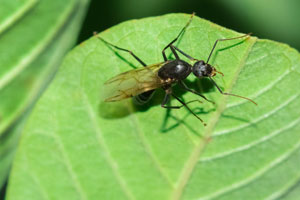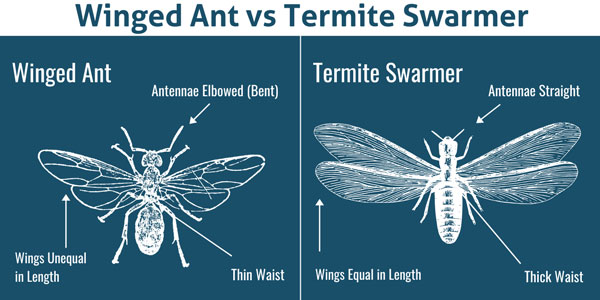
Termites and flying ants: what’s the difference? Flying ants, known as carpenter ants, can cause a lot of damage with their wood-boring abilities. However, termites are even more dangerous! In the swarmer stages of their lives, these two wood-destroying insects are commonly mistaken for each other. Although they both destroy wood, they are quite different from one another. Keep reading to learn expert tips on the differences between termites & carpenter ants from the professionals at Rentokil.
How to Tell Termites Apart from Carpenter Ants
Termite and carpenter swarmers certainly look alike, but there are several key differences. The best way to differentiate the two is to look at the size of their wings in proportion to their bodies. Flying carpenter ants are black in color, but can have a slight red hue as well. The most telling feature of carpenter ants is that they measure 1/2″–5/8″ with antennae bent at a 45-degree angle. Carpenter ant swarmers are larger than termites, which is a good way to tell them apart.
Meanwhile, termite swarmers are dark brown to black in color and measure 3/8″ long including the wings. Their wings are a translucent to slightly milky or smoky color, may overlap, and are typically as long as or slightly longer than the body. This is the best way to differentiate them from carpenter ants.

Behaviors of Wood-Destroying Insects
Termites and carpenter ants both tunnel through wood, but termites are typically more destructive. The main things to know about these wood-boring insects are:
- Termites make their way into a structure around basement windows, doorways, under siding, porches, or any structure in contact with the soil.
- Established termite colonies can range from 60,000 to over a million workers and can consume nearly 5 grams of wood per day.
- Carpenter ants establish nests in wood that is already in decay, and later expand into normal wood, insulation, or wall voids.
- Excavated termite galleries appear to have been sanded. Carpenter ants do not create the extensive damage termites do.
How to Control Termites and Carpenter Ants
Wood-destroying insects are feared by all property owners, and for good reason! Flying ants, known as carpenter ants, are the most destructive ant species in the nation. However, they don’t hold a torch to the damage caused by termites annually! Your best defense against a wood-destroying insect is to sign up for annual inspections from a professional pest control company such as Rentokil. We can help you learn how to tell the differences between termites & carpenter ants.
Important Differences Between Termites & Carpenter Ants in Salt Lake County and Northern Utah
Serving Northern Utah and Southern Idaho since 1999
